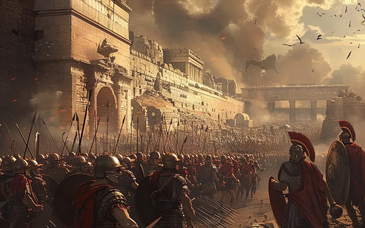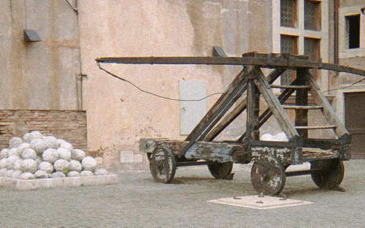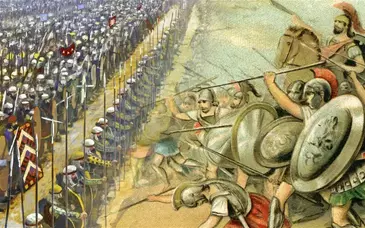Corvus - a Roman military boarding device used in naval warfare
The corvus ("crow" in Latin) or harpago (probably the correct ancient name) was a Roman military boarding device used in naval warfare during the First Punic War against Carthage.

In the book History, by Polybius, he describes this device as a bridge 1.2 m (4 ft) wide and 10.9 m (36 ft) long, with a small parapet on both sides. The engine was probably used in the prow of the ship, where a system of pulleys and a pole allowed the bridge to be raised and lowered. There was a heavy spike shaped as a bird's beak on the underside of the device. The spike was designed to pierce the enemy ship's deck when the boarding-bridge was lowered. This allowed a firm grip between the vessels and a route for the legionaries to cross to the other ship.
In the 3rd century BC, Rome was not a naval power and had little or no experience in war at sea. Before the first Punic war, the Roman Republic had not campaigned outside the Italian Peninsula. The Republic's military strength was on land, and her greatest assets were the discipline and courage of her soldiers. The boarding-bridge allowed her to use her marines against the superior Carthaginian naval skills. The Romans' application of boarding tactics worked; they won several battles, most notably those of Mylae, Sulci, Tyndaris, and Ecnomus.
Despite its advantages, the boarding bridge had serious drawbacks: it could not be used in rough seas since the stable connection of two working ships endangered each other's structure. Operating in rough seas, the device became useless and was abandoned. According to Bonebaker, Professor of Naval Architecture at Delft, with the estimated weight of one ton for the boarding bridge, it is "most improbable that the stability of a quinquereme with a displacement of about 250m³ would be seriously upset".
Some other historians believe that its weight on the prow compromised the ship's navigability and the Romans lost almost two entire fleets to storms in 255 and in 249 BC, largely due to the instability caused by the device. These losses were probably the main reason for the abandonment of the boarding-bridge in ship design by the end of the war. As Roman naval tactics improved and the Roman crews became more experienced, the boarding-bridge was no longer used in battle. It is not mentioned in period sources after the battle of Ecnomus and apparently the Battle of the Aegates Islands that decided the first Punic war was won without it.
A variant of the boarding bridge, called arpax or harpax, was used in the Battle of Naulochus.


